WE RIDE DICKS RACING’S 2019 KTM 300XC-W TPI MOTOCROSS MOD
The brave new world of two-strokes is going to be fuel-injected, but for now there are no fuel-injected motocross bikes on the showroom floors. The 2019 EFI offerings are limited to the KTM and Husqvarna off-road models in 250cc and 300cc versions. And, strangely, these fuel-injected two-strokes were not built with the American enduro market in mind. Instead, they were built to help meet the continent’s very strict Euro4 emission standards. As the KTM 250/300XC-W TPI and Husqvarna TE250/300i sit, they are not suitable for motocross use with their wide-ratio, six-speed gearboxes; soft XPlor forks; lighting components; kickstands; enduro fuel tanks; year-old enduro frames; 18-inch rear wheels and added weight.
WE ARE WELL AWARE OF THE PROBLEMS ASSOCIATED WITH TURNING A 300cc ENDURO BIKE INTO A MOTOCROSS BIKE—THIS WASN’T OUR FIRST 300 RODEO. IN FACT, THE LAST TIME WE TRIED TO TURN A KTM XC300 INTO A 300SX, WE VOWED TO NEVER DO IT AGAIN.
The MXA wrecking crew wanted a non-existent 2019 KTM 300SX-TPI motocross bike. KTM said that they didn’t make such a machine, so we did the next best thing. We commissioned Husky/KTM guru Dick Wilk of Dicks Racing to build us one. Although we don’t remember ever saying that money was no object, Dick spared no expense on what turned out to be much more than a simple garage project. By the time our 300SX-TPI project bike was ready to hit the track, Dick had modified the cylinder head, throttle body, fuel injection, exhaust pipe, clutch, forks, shock, plastic, radiator cap, wheels and brake rotors. But, when it was rolled out into the sun, all we could say was, “Wow.” It didn’t look like an enduro bike anymore.

We are well aware of the problems associated with turning a 300cc enduro bike into a motocross bike. This wasn’t our first 300 rodeo. In fact, the last time we tried to turn a KTM XC300 into a 300SX, we vowed to never do it again. From that point on, we stuck with putting 300cc engine kits on our 250SX race bikes. We still recommend this path for anyone who wants a 300cc TC300 or 300SX motocross bike; it’s less painful. But, the 2019 300XC-W TPI top-end could not be swapped over to our 2019 KTM 250SX engine cases. Thus, the only way to get a fuel-injected two-stroke motocross bike was to accept the complete enduro bike, warts and all. We should also mention that we wanted the fuel-injected 300XC-W TPI instead of the 250XC-W TPI because we rode both at Erzberg and fell in love with the 300’s torquey powerband.
In stock trim, the 2019 KTM 300XC-W-TPI could be ridden on a motocross track. We tried. It had some obvious limitations. The forks were too soft. The chassis was out of balance. The engine had two distinct powerbands (a doggy low-to-mid and a hyperkinetic mid-to-top), and the gear ratios were best at going very slow or very fast, not for the mid-speeds of modern motocross. We told Dick Wilk what we wanted, what we didn’t like about the stocker, and put no restrictions on what he could do. The bike he delivered to us was a thing of beauty, on and off the track.
THE STOCK 300XC-W TPI ENGINE DIDN’T NEED TO BE HOPPED UP. IT MADE A HAIR UNDER 50 HORSEPOWER WITH NOTHING DONE TO IT. OUR REQUEST WAS THAT DICK BE THE “HORSEPOWER WHISPERER.” WE WANTED ONE POWERBAND, NOT TWO.
The stock 300XC-W TPI engine didn’t need to be hopped up. It made a hair under 50 horsepower with nothing done to it. Our request was that Dick be the “horsepower whisperer.” We wanted one powerband, not two. We had no interest in a fire-breathing 300cc two-stroke; we just wanted the 300XC-W TPI bottom to be cleaned up and the transition between the mid and top to be more fluid. Here is what Dick did.
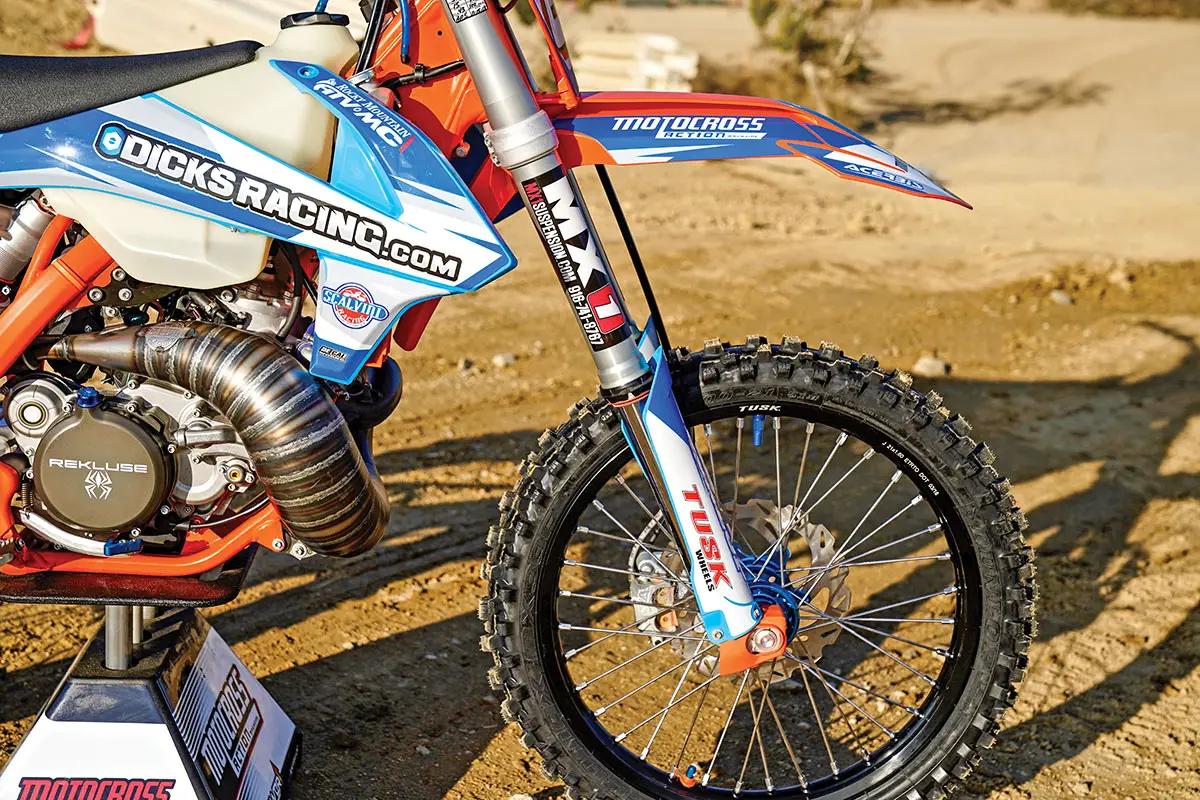
Cylinder head. The 300XC-W TPI cylinder head was milled to slightly increase the compression, which would help perk up the hit at low rpm. Additionally, Dick added his proprietary torque grooves in a ring around the squish band to improve combustion efficiency. Dick claims the torque grooves help funnel the misted fuel to the spark plug. Although we’ve never seen a grooved combustion chamber before, we had no issues with pinging during our test sessions.
Air intake. Dick installed a Thunder Product’s Quad Flow torque wing in the 39mm Dell’Oorto throttle body. Similar in design to a Boyesen Power Wing, the vertical and horizontal winglets take the turbulent air exiting the throttle body and straighten it out. The goal is to achieve a smooth, uninterrupted flow of laminar air over the contour of a wing to reduce surface friction drag. These simple little winglets look strange, but MXA has enough experience with them to know that they help. This Quad Flow torque wing was specifically designed for the fuel-injected KTM and Husky engines.
Pipe. For an expansion chamber and silencer, Dick chose an Italian-made Scalvini cone pipe and silencer for improved top-end power.
EFI. The increased compression and Scalvini pipe pushed the stock ECU fuel mapping out of its program. To solve this, a JD jetting fuel tuner was installed under the seat to alter the fueling to match the mods. The JD Power Surge 6X allows corrections for humidity, temperature and air pressure, along with race fuels and engine modifications. Most important for the 300XC-W TPI is that the JD Jetting tuner solved what would have been old-school jetting problems.

And that was it for the engine. It cost $195 for the head mods, $150 for the Quad torque wing (installed), $245 for the JD Power Surge 6X tuner, $339 for the Scalvini cone pipe and $179 for the Scalvini aluminum muffler. The total engine costs were $1109.
MAKING THE KTM 300XC-W TPI ENGINE STRONGER WOULD ONLY HAVE AGGRAVATED OUR SUSPENSION ISSUES. WHAT WE WANTED WERE STIFFER FORKS, BETTER REAR SUSPENSION AND A SHORTER OVERALL HEIGHT, SINCE THE STOCK PDS BIKE IS VERY TALL.
We knew that making the KTM 300XC-W TPI engine stronger would only have aggravated our suspension issues. For an off-road bike, the stock setup is perfect, which means that it doesn’t have much chance over big jumps or whoops. What we wanted from Dick Wilk was stiffer forks, better rear suspension and a shorter overall height, since the stock PDS bike is very tall.
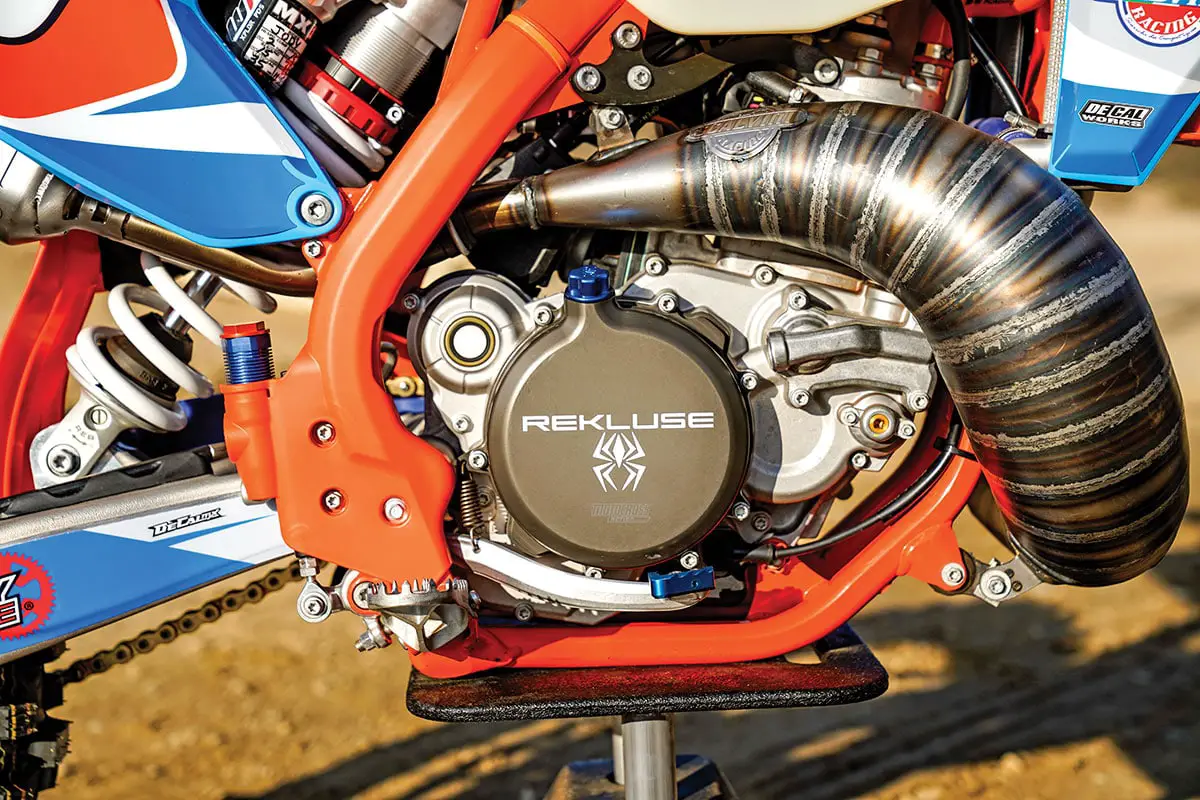
Forks. It is important to note that the KTM 300XC-W TPI does not come with 48mm WP AER air forks. It doesn’t come with WP 4CS forks, either. Nope, it comes with WP Xplor forks. You’ve probably never heard of them. They are WP’s off-road enduro forks.
REMEMBER WHEN WE SAID THAT WE “PUT NO RESTRICTIONS ON WHAT HE COULD DO”? DICK REMEMBERED IT. AND, AS A SURPRISE, THAT TURNED OUT TO BE A GIFT; DICK TOOK THE LIBERTY OF INSTALLING AN AUTOMATIC CLUTCH SYSTEM.
The stock Xplor forks are painfully soft for motocross. Basically, one fork leg does all the damping and the other fork does nothing. Dick CNC-machines a real piston and converts the left fork into the APS system that worked so well on WP’s 4CS forks. APS stands for Advanced Progressive System and uses bypass technology to blend the fork’s travel into a single, seamless flow. Instead of being too harsh at the beginning of the stroke or too soft at the end of the stroke, Dick Wilk’s system constantly blows off excess pressure as the fork moves through its stroke, thus it can be set up to be plush without bottoming or stiff without being jarring. How does bypass technology work? Dick’s MX1 Suspension shop puts bleed holes in the left fork leg cartridge. Three small 3mm holes are drilled at 5 inches, 7 inches and 9 inches of travel to provide progressive compression damping that is not only speed sensitive but position sensitive as well. The right fork is re-valved for less dive, more rebound control and reduced blow-through. These two forks combined make the compression and rebound easily tunable via adjusters on top of the forks. The stock fork springs were utilized to match the shorter shock.
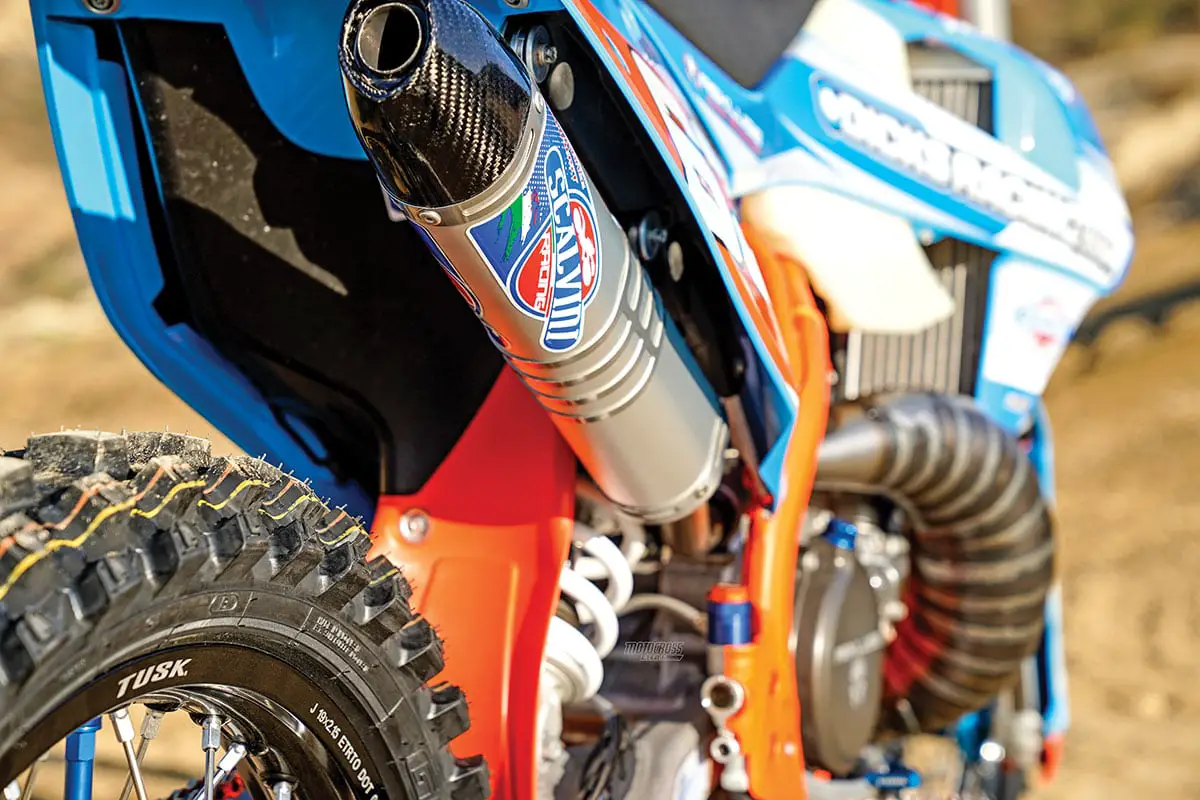
Shock. In case you don’t follow the minutia of KTM and Husqvarna differences when it comes to fuel-injected two-strokes, the 2019 Husqvarna TE300i comes with rising-rate shock linkage (albeit the old rate change), while the 2019 KTM 300XC-W TPI comes with a single-sided, no-link, PDS rear shock. You don’t need to be in Sherlock Holmes’ Facebook group to know that KTM has not used PDS on a motocross bike since 2010; however, they never dropped it on their enduro bikes. Why not? First, it is lighter by over 5 pounds. Second, without the linkage hanging down, the PDS-equipped bikes can slide over rocks and logs easier. Third, PDS suspension is easy to work on and very low maintenance. There are no bushings or bearings to grease. But, in MXA’s experience, PDS is very shock spring-rate sensitive. Get the correct spring for your intended use and weight, and you will be a happy camper. Miss it, and it will feel weird. Dick has tuned thousands of PDS shocks. He shortened our shock to reduce seat height and rear-wheel travel, added a stiffer progressive-rate shock spring (6.3 kg/mm to 6.9kg/mm), increased the compression damping and slowed the rebound damping.
Plus, with the PDS system being 5 pounds lighter than a linkage bike and Dick knocking off 6 pounds by removing all of the enduro fluff, our fuel-injected 300XC-W TPI bike was way under the claimed 220-pound dry weight.
And that was it for the suspension. It cost $425 for the APS fork mods, $210 for the shock re-valve, $125 for the shock lowering and $145 for the progressive-rate shock spring. The total suspension costs were $905.

Remember when we said that we “put no restrictions on what he could do”? Dick remembered it. And, as a surprise, that turned out to be a gift; Dick took the liberty of installing an automatic clutch system. The $999 Rekluse RadiusCX clutch is a relatively simple auto-clutch system that slips into the existing (and terrific) KTM steel clutch basket. RadiusCX combines Rekluse EXP, TorqDrive and Core technology into one slip-in package. You don’t need to change the clutch basket; all you have to do is put in the Core inner hub and pressure plate, TorqDrive clutch plates, EXP auto-clutch pack and Rekluse adjustable push-rod clutch slave unit. We have ridden automatic-clutch bikes in the past but always found ourselves using the clutch lever anyway. It was a habit that was hard to break. The good thing about a Rekluse auto-clutch is that you can use the clutch lever as on a normal motorcycle, but you don’t actually need it. We vowed to never touch the clutch lever when racing the Dick’s Racing 300XC-W TPI machine. We were amazed. It took test riders a lap or two to stop reaching for the lever, but once we settled into letting the Rekluse do all the work, all we had to do was shift.
The best thing about the Radius CX clutch was that we quickly discovered that we could go into corners much deeper, use maximum braking and get back on the throttle sooner. We never touched the clutch, because with the auto-clutch, the engine could not stall. The EXP pack uses slinger-style weights that pull the clutch in when they recognize that you are below minimum chain-snatch speed. It was the best experience on all levels that we ever had with a clutch.
Our 2019 KTM 300XC-W TPI was equipped with Tusk wheels, largely because we wanted to swap the stock 18-inch rear wheel for a 19-inch wheel. And once we laced up one blue hub, we realized that we needed a second one to make the bike look right. The front and rear wheels cost us $545. Other small changes include a 2.0 radiator cap, STR fork bleeders and suspension adjusters, A’ME clamp-on grips, and Acerbis blue/orange plastic.
What was it like to race? It was like a day in the park. You can’t imagine how restful it was to race a fuel-injected two-stroke, especially one with a strong powerband and good suspension. First, we didn’t have to pre-mix oil in the gas. Second, we didn’t have to kick it to start it. Third, we could let it idle on the bike stand and walk away (thanks to EFI). Fourth, we could touch the ground while sitting on the starting line (thanks to the shorter rear shock). Fifth, we never had to worry about filling the gas tank, because it held 2.4 gallons and we could see the fuel through the translucent plastic tank. Sixth, we didn’t have to get antsy on the starting line, because all we had to do was turn the throttle on when the gate dropped (no need to use the clutch). Seventh, we never stalled, no matter how hot we came into a tight right. Eighth, the Dick’s Racing mods cleaned up the powerband glitches that we had with the stocker, punched up the midrange and gave us a 50-horsepower two-smoke. Ninth, we can race the bike in Death Valley or at Mammoth Mountain without changing the jetting.
WHAT WAS IT LIKE TO RACE? IT WAS LIKE A DAY IN THE PARK. YOU CAN’T IMAGINE HOW RESTFUL IT WAS TO RACE A FUEL-INJECTED TWO-STROKE, ESPECIALLY ONE WITH A STRONG POWERBAND AND GOOD SUSPENSION.
All the MXA test riders loved this project bike. It was unique. When the bills were added up, we spent $3000 turning a $9899 KTM 300XC-W TPI into a motocross bike. But, $1000 of that was for the Rekluse automatic clutch that not every motocross racer would want, and, if you can live with the 18-inch rear wheel (and there are MXA test riders who still believe that the 18-incher is a better all-around tire for local motocross), you could save another $550. That would bring the price of our mechanical mods down to $2000. For more information, contact Dick’s Racing at (916) 705-3193 or www.dicksracing.com.


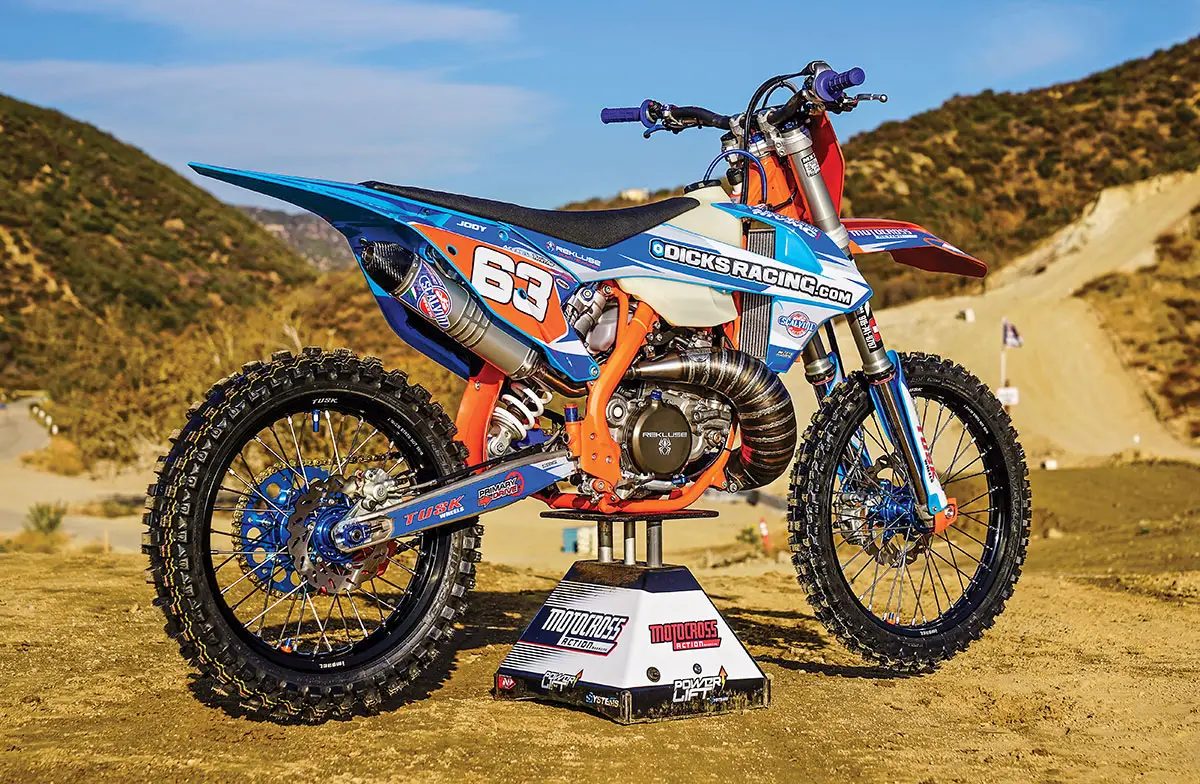

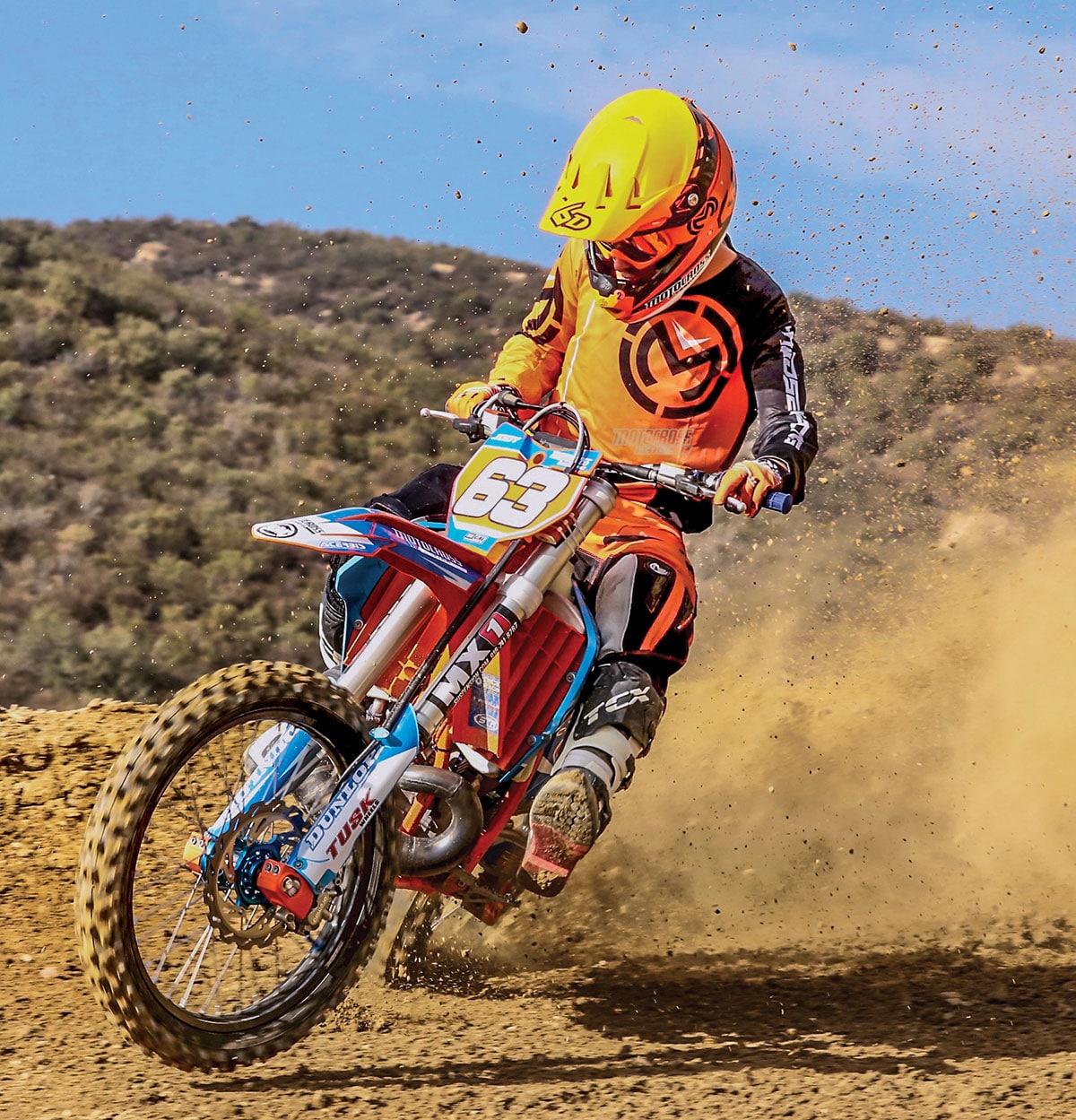


Comments are closed.